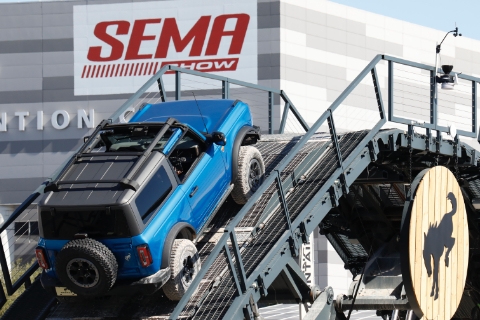SEMA News - August 2009
By Steve Campbell
Illustration Colby Martin
All Segments of the Industry Have an Interest in Employing Common Standards
 Just because a company has a highly detailed Excel spreadsheet that provides two dozen fields jammed with product data doesn’t mean that it has good data. Data is simply information. Good data is the appropriate information provided in correct formats.
Just because a company has a highly detailed Excel spreadsheet that provides two dozen fields jammed with product data doesn’t mean that it has good data. Data is simply information. Good data is the appropriate information provided in correct formats.
As it pertains to automotive specialty-equipment businesses, data is the size, weight, quantity, price and other descriptive factors that tell a distributor, jobber or dealer about a manufacturer’s product. Ultimately, it’s the information that allows the distribution chain to pass the right product at the proper price from the maker to the end user. But as information is computerized and exchanged electronically—transformed from a written description at one end into a numeric code that is read by a machine and then reformed back into a written description at the other end—data must be strictly standardized in order to be valid. And it’s very easy for one company’s written description to be lost in translation as it moves to another company’s computer.
Bob Moore, president of Bob Moore+Partners and a member of SEMA’s Business Technology Committee, offered an excellent example: “I loaded a song by the Doobie Brothers onto my iPod,” he said. “But when I wanted to listen to it, I couldn’t find it. After scrolling through almost my entire catalog of artists, I discovered that, rather than indexing the group under ‘D’ for Doobie, my iPod had indexed it under ‘T’ for The Doobie Brothers.”
One of the most popular automotive brands in the world is fodder for another example. If Manufacturer A enters a Chevrolet part as being for a Chevy but its distributors’ computer recognizes only the automaker’s full name, the data transfer will be confused. Then throw in the jobber’s misinterpretation when its computer is looking for Chev, because that’s what the data-entry person learned to call the brand growing up. The result is a flurry of phone calls and delays—often outright missed sales—because of a basic data error. And we haven’t even mentioned the disorder wreaked by Chevy/GMC.
Human beings have the undeniable advantage of being able to interpret words, signals, signs and even subtle gestures. We immediately and automatically understand that Chevrolet, Chevy, Chev and even Chevie stand for the same company. We know that a pack is a unit that contains more than one individual item, though we might also call it a package or a box or even a crate. But a computer sees each of those terms as a distinctly different item. Any missing or incorrectly added bit of information stymies a computer’s ability to find or correctly categorize data. That’s why industry-wide data standardization has become so important.
The Product Information Exchange Standard (PIES) was developed to create universally accepted formats for key product-data items, including part number, part type, weight, size, pricing and more. As the electronic transfer of product information has proliferated and become the most widespread means by which commerce is conducted, all companies in all segments of the industry have a vested interest in employing common data standards.
Some companies—especially those that deal with a large assortment of parts or those small enough not to have a dedicated data manager—may be intimidated by the idea of having to standardize product data. And, to be realistic, it is a process that takes some time and effort. But so does picking up the phone for one transaction after another to sort out why an order was incomplete or the wrong part was shipped or the wrong quantity was received. Once standardization is complete, those problems don’t occur, and we can get on with the business of providing the parts people want to buy.
Learn more about standards and find resources.
A Glossary of Terms
A Quick Primer on Speaking Geek
By Gigi Ho
 AAIA Legacy: The original Automotive Aftermarket Industry Association electronic catalog standard for vehicle year, make, model and engine. Files are delivered in a flat file format.
AAIA Legacy: The original Automotive Aftermarket Industry Association electronic catalog standard for vehicle year, make, model and engine. Files are delivered in a flat file format.
ACES (AAIA Catalog Enhanced Standard): The current electronic cataloging standard, replacing Legacy, comprised of vehicle year, make, model, engine and vehicle attributes in a relational database. Files are delivered in an XML format.
PIES (Product Information Exchange Standards): Standardized fields of product information such as part number, descriptions, pricing, dimensions, weight, packaging, etc. Files are delivered in an XML format.
Delimited Text File: A flat file format that is an array of data separated by any character. The most common delimiters are tabs, commas and vertical bars (AKA “pipe”).
XML (Extensible Mark-Up Language): Tags that define and validate data and facilitate transmission and interpretation of data between two or more companies’ systems, the supplier of data and the receiver(s) of data.
Relational Database: A database whose structure is made up of numerous separate but linked tables of information. One of the advantages of a relational database is that duplication of entries is reduced or even eliminated. In a parts database, for example, there would be a separate table for part types/categories. For each part summary, a link is made to the applicable part type/category in the part type table. As a result the word “turbocharger” would actually be entered only once in the database but would appear linked in all applicable records.
Data Mapping/Cataloging: The creation of a full record of information about a part, cross-referenced to other records and files. Catalogers often prepare and keep up the information about the parts. Some of the information recorded includes the brand name, part descriptions, dimensions, photos, fitment on a vehicle, etc.








